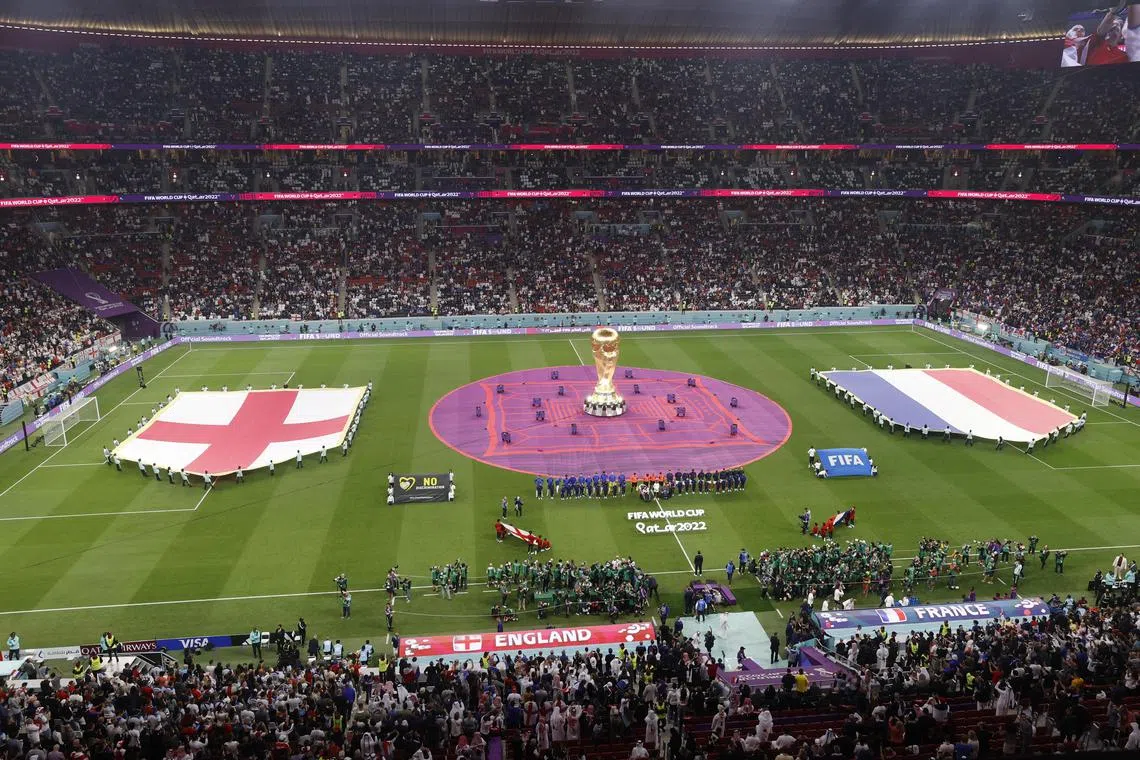World Cup: Tournament going from compact to super-sized in 2026
Sign up now: Get the biggest sports news in your inbox

The opening ceremony before the World Cup quarter-final between England and France at Al-Bayt Stadium.
PHOTO: EPA-EFE
Follow topic:
TORONTO – With the most compact World Cup ever reaching a climax on Sunday in Qatar, the baton will be passed to 2026 co-hosts the United States, Mexico and Canada for what will be a super-sized global football showcase
After controversially awarding 2022 host duties to Qatar,
The last time Mexico (1986) and the US (1994) hosted a World Cup, there were 24 teams.
With 16 cities across America, Canada and Mexico staging matches, the logistics will be mind-boggling even before adding in 48 team training bases.
The 2026 tournament will return to its traditional summer window after being played in November and December in Qatar to avoid searing June and July temperatures.
Most of the competition will be in the US, which will see 11 cities from New York to Los Angeles get 60 of the 80 matches, including the quarter-finals, semi-finals and final.
Mexico City, Guadalajara and Monterrey are the Mexico venues, with Toronto and Vancouver getting Canadian hosting responsibilities.
While the Qatar World Cup was at times overshadowed by the Gulf state’s treatment of migrant labour and its approach to LGBTQ rights and other restrictive social laws, Fifa president Gianni Infantino on Friday heaped praise on the action on the pitch, describing the tournament as the best ever.
That tried and tested format of eight groups of four teams, which has kept hundreds of millions of fans enthralled, could be ripped up for 2026 as Fifa considers plans to have 16 groups of three teams in the first phase.
However, Infantino has also said that he is looking to have another discussion regarding this.
Regardless of the format, more teams will mean more surprises, like Saudi Arabia beating Argentina in their group opener, says Jurgen Klinsmann, who won a World Cup with Germany and later coached the US men’s team.
“We are going to see more surprises coming from Africa and Asia in the (2026) tournament,” Klinsmann, the head of Fifa’s technical group, told reporters in Qatar.
The 32-team World Cup in Qatar has a total of 64 matches, completed in 29 days, and, for now, the 2026 Finals will be 80 games over 32 days.
With four-team groups, there would be 104 matches, requiring at least an extra week.
More matches, however, would mean more television rights money and, as the World Cup brings in some 90 per cent of Fifa’s revenue, its leaders will be tempted.
The World Cup in Qatar has earned US$7.5 billion (S$10.2 billion) in rights and sponsorship revenue, US$1 billion more than the 2018 Finals in Russia, Fifa said in November.
One sponsor almost certainly looking forward to 2026 is Budweiser, the official beer of the World Cup, which saw the taps at stadiums turned off by Qatari officials just days before the start.
The first World Cup held in a conservative Muslim country with strict controls on drinking, it was a challenge to find beer or alcohol in Qatar and, when it was available, it was expensive.
But in 2026, the taps will be flowing at all the stadiums along with fan zones packed with thirsty supporters. REUTERS

